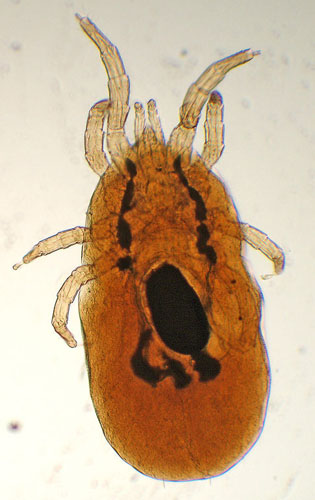Acarina

The red mite Dermanyssus gallinae
Image source: Wikipedia.
Acarina, also called Acari, is an order of arachnids which includes mites and ticks. Approximately 50,000 species are known. The Acarina are extremely abundant animals, found almost everywhere. In terms of their economic impact they are the most important arachnid order; many species are parasitic on man or domestic animals, e.g., Sarcoptes causes scabies and the cattle tick carries babesiosis (redwater fever).
Mites and ticks are small, usually less than 1 centimeter in size, and have a body that is divided into two main regions: the cephalothorax and the abdomen. Acarine larvae usually have three pairs of legs; adults have four pairs of legs and a tough exoskeleton, which protects their body and helps them move. They are ectothermic, meaning that their body temperature is regulated by the environment, and they rely on external sources of heat to maintain their body temperature.
Mites and ticks can be divided into two main groups: free-living and parasitic. Free-living mites are not dependent on other organisms for their survival and can be found in a variety of habitats, including soil, water, and vegetation. They play important roles in ecosystems as decomposers and predators of other small organisms.
Parasitic mites and ticks, on the other hand, rely on other organisms for their survival. They feed on the blood or tissues of their host and can cause significant damage to the host's health. Some common examples of parasitic mites and ticks include scabies mites, which cause scabies in humans; ticks, which can transmit diseases such as Lyme disease and Rocky Mountain spotted fever; and chiggers, which can cause intense itching and inflammation.
Mites and ticks are important vectors of diseases, and can transmit a range of pathogens to humans and animals. They are particularly important in the transmission of zoonotic diseases, which are diseases that can be transmitted from animals to humans.
Treatment of mite and tick-borne diseases typically involves the use of medications to kill the parasites and relieve symptoms. In the case of scabies, for example, treatment involves the use of topical creams or lotions that kill the mites and eggs. For tick-borne diseases, prompt removal of the tick is important to prevent the transmission of the disease.
Prevention of mite and tick-borne diseases involves avoiding contact with the parasites, which can be achieved through the use of protective clothing, insect repellents, and avoiding areas where mites and ticks are known to be present. Regular tick checks and removal of ticks are also important to prevent the transmission of tick-borne diseases.


